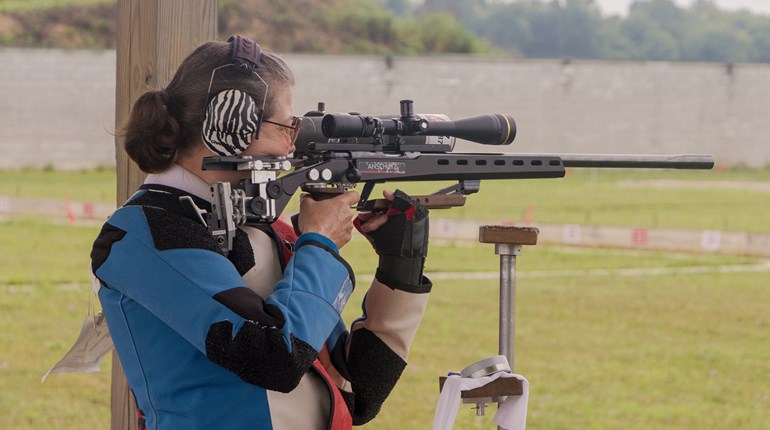
I have been around guns and shooting for more than half a century, which means I’ve seen a lot of shooting fads come and go. While I might be an old dog, I can still learn new tricks, and I am always trying to improve my shooting skills. Unlike a lot of folks in my generation, I try not to get too set in my ways, at least when it comes to shooting and staying current. I am always doing my best to keep up with new developments, new techniques and new guns.
In recent years, there has been a lot of chatter about feeling the trigger reset when shooting a pistol. The technique is often described as follows:
1. At the shot, trap the trigger back with your finger.
2. Align the sights and let the trigger come forward until you feel the reset.
3. Break the next shot.
The idea is that you will move your finger a shorter distance than if you come off the trigger and let the gun reset itself after the shot.
I have been shooting handguns since the early 1970s, and I confess that all too often I still struggle with trigger issues. So, I thought perhaps this “feel the reset” thing might help.
I tried it extensively with several different handguns, and in the end, it’s not for me. My basic technique for shooting fast is to let the finger come off the trigger during recoil so the gun resets, take up the slack and prep the trigger for the next shot as the sights align, then finish the press to break the shot. That’s pretty much what this old dog learned a long time ago, and it’s served me well, including in some serious competitive shooting. Many of the best pistol shooters in the world use this technique, which should be a huge clue.
Still, feeling the reset has gained a lot of traction in the shooting world. The PR people from the gun companies often talk about the “tactile trigger reset” on their new pistols. At the gun store and at shows like SHOT, I hear shooters commenting on trigger reset with an intensity and focus that says they mean business. I recently watched a guy buy a new handgun based on the reset alone. My brother even attended a pistol course at a famous shooting school where they focused heavily on feeling the trigger reset. It’s become a big part of shooting culture.
There is no argument: the key to shooting any handgun well is control when the trigger is going in the other direction. Pulling the trigger back and breaking the shot without causing movement to the sight picture is the key to releasing a well-aimed round. Maintaining control over the trigger’s forward movement, which has no bearing at all in actually firing the handgun, just doesn’t make sense to me.

I suppose it has some merit for teaching entry-level shooters, to help make them more aware of how the trigger works, and to add focus on the trigger early in the learning curve. For serious pistol shooting in a defensive or competitive situation, however, it seems to me like it will slow down split times between shots, and has the potential to confuse the shooter when he or she needs to be thinking clearly. That confusion can result in a short stroke so the trigger fails to reset, resulting in lost points in competition, or disaster in a defensive situation.
Anyway, I think I gave it a fair trial, though I did ultimately rule against it for my shooting. But then, that’s my opinion. Opinions are like armpits, we all have them, and they all stink except mine. Like I said, I am always open to learning something new, but only if it brings improvement to the table. I am not seeing that here, but I could be wrong. As such, I thought it might be interesting to contact some top shooters and instructors, and see what they have to say on the subject.
It broke down about as I expected. Most competitive shooters don’t pay any attention to the reset, even many who are also instructors. Most instructors do focus on the reset, but with caveats; usually just at the entry level to help learn about trigger control and to make the shooter focus on the trigger. There isn’t enough room for all of the responses, but here are some highlights.

Bruce Piatt is a top pistol shooter in multiple disciplines. As an instructor he taught a lot of cops and civilians how to shoot:
I don’t concern myself with reset, especially the faster I go. I do not teach anything about reset. Many instructors, especially the Glock crowd, train for releasing just until the click of the reset and then start the trigger press. I’ve seen so many shooters who struggle with trigger issues spend so much time slowly resetting the trigger. Then, as soon as they feel the click, they smash the trigger and still miss the target.
On a striker-fired trigger you should be able to pull the trigger to the “stop” where the trigger starts to get heavy, which is the same spot the click is felt at reset, then begin your trigger press.

Julie A. Golob is one of the top competitive shooters in the world:
As someone who shoots many different firearms, from rifles to revolvers and everything in between, I focus more on the beginning of the trigger press. Short stroking, or not being used to the trigger reset on a gun, can be costly in competition, even more so when it really matters.

Jerry Miculek is one of the best and fastest pistol shooters on earth. His reply was short and on point:
“I can’t say I ever feel reset. Guess it happens, but I don’t know it.”

Scott McGregor is one of the top 3-gun shooters in the country, and says:
I don’t necessarily need to feel the click of the reset. I allow the trigger to reset as the slide is cycling and then re-establish the finger placement, take up any travel and be ready to squeeze again.

Max Michel, Jr. is a world champion shooter and instructor, who states:
I prefer to have my students come all the way off the trigger. In a stressful situation (combative or competitively), it’s important to be sure the trigger is reset to avoid trigger freeze. In fact, depending on the distance or difficulty of the target, I have my students slap the trigger for speed, but as the target gets smaller/farther it becomes more of a controlled slap. In other words, I reset the gun in recoil and work the trigger as fast as possible without disturbing the sight off of the target. The distance/difficulty will always dictate the trigger speed but never how quickly I reset the trigger.

Dianna Liedorff Muller is a top 3-gun shooter and instructor:
I do not feel the trigger reset, but I shoot mostly with a 2011, so I think it’s less pronounced than say a Glock or other striker-fired gun. On the other hand, I have shot a lot of Glocks in my day, and I didn’t intentionally feel the reset.
I have also taught feeling the reset to point out control. It helps students understand that the more they control from the brain to finger, the less likely they are to disturb their sights. But, it’s just to that end: to understand control and what the trigger feels like, not necessarily to carry it on to everyday shooting. I think intentionally trying to feel the reset slows you down and lends itself to failing to hit the reset occasionally.

Scott Ballard worked as an executive/dignitary protection specialist. He is a former instructor with the SIG Sauer Academy, and is a current instructor with D-TAC Academy:
A new shooter needs to focus on fundamentals, and awareness of the trigger reset helps them to better understand how the gun works and how their interaction with the firearm directly relates to accuracy. Teaching them to use the reset as a base for shot delivery makes them successful much faster than avoiding the topic altogether.
After the shooters master the fundamentals and begin to branch off into the more advanced disciplines (i.e., self-defense, target, action-shooting sports), I feel it is time to put aside the reset crutch and focus on the bigger-picture items required for rapid and accurate shot delivery.
Interviews with people who have been involved in actual shootings tells me that any conscious recognition of trigger reset goes out the window once their self-preservation instincts take over.
Trigger reset is not what aims the firearm and it is not what sends the round downrange. Don’t over-focus on something that ultimately does not matter.

Sheriff Jim Wilson is Shooting Illustrated’s Senior Field Editor and an instructor:
I like to teach the student to feel the trigger reset, because repetition teaches him trigger control that will transfer over, somewhat, in an actual gunfight situation.

Sheriff Ken Campbell (Ret.) is the chief operating officer for Gunsite Academy:
We teach trigger reset at Gunsite Academy. Initially, we focus on you feeling the click as you ease your finger out. If you let your finger fly off the trigger, your follow-up shots are less accurate as you tend to slap the trigger. They are also slower. As the class progresses, the reset is much quicker as the student gets stronger.
As you develop your skill sets to the Unconscious Competence level, I don’t think you really feel it, but know it has happened.

Travis Gibson is the owner of MGM Targets and a top competitor in the 3-gun world:
On high-focus targets, for sure, feel the reset. On low-focus targets, complete slapping of the trigger.

Il Ling New is an instructor at Gunsite Academy:
I think that feeling reset is a critical part of learning how to shoot a handgun, and I teach it to all beginner/novices. I also address the concept with those who might consider themselves to be beyond beginner/novice level, if they do not know what it is.
Why address this? Because I believe it’s a critical part of learning to control the trigger finger—and conversely, learning not to simply allow the finger (and even other parts of the upper body) to involuntarily react to recoil—whether flying off the trigger, losing grip, flinching, etc.
If a high-intermediate shooter is consistently accurate and precise at challenging speeds, I would not add the technique to the mix. I also know some very high-level competitive shooters who do not work reset, and they feel that coming off the trigger between shots is faster—at their level, I defer to them.

Todd Smallwood is an instructor at Armed Citizen firearms training:
I think trigger reset is an important part of shooting fundamentals for beginners. When I’m teaching someone basic handgun or even defensive handgun fundamentals, we spend time on trigger reset as part of trigger control and follow-through. It helps build stability and efficiency in their actions and movements, which makes things easier to repeat. Fire, reset, sight picture, repeat. Once a student moves on to intermediate and advanced shooting that focus becomes less important to me. At that point we are usually working on other things to improve accuracy and speed.

George Harris is a co-founder of the SIG Sauer Academy and is currently President and CEO of International Firearms Consultants:
I teach foundational-level shooters to reset the trigger to help with mechanics, follow-through, and eliminating deficiencies such as jerking, etc. Once the shooter can handle the trigger without the loss of accuracy, either slow or fast, I will introduce them to slapping the trigger as a means to gain a little speed if it works for them. Some make the transition and others don’t. In either case the muzzle has to be pointed at the target when the bullet exits the muzzle and the trigger manipulation has a lot to do with making that happen.
Well, there you have it—the experts’ advice. Though always a good starting point to ensure you aren’t just spinning your wheels, I guess in the end it’s really up to you as a shooter to decide if you want to embrace the “feel-the-trigger-reset” technique. So grab some ammo, head on out to the range, and see what works best for you.






































